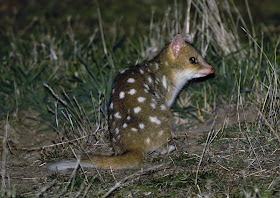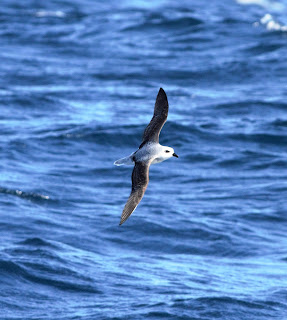Saturday, 29 May 2021
Night Parrot records from Diamantina National Park
The critically endangered Night Parrot (image above by John Young) has been found in at least three sites in Queensland’s Diamantina National Park where they were recorded earlier by north Queensland naturalist John Young. The revelation, in a 2019 report to the Australian Wildlife Conservancy, raises questions about suggestions by authorities that there is no evidence of the bird being resident in the park.
Young was sacked from his job in September 2018 as a senior ecologist with the AWC amid allegations that he fabricated evidence of Night Parrot records in Diamantina National Park and in Kalamurina Wildlife Sanctuary in South Australia. The AWC said it was retracting all its Night Parrot records from Diamantina National Park and other sites.
In a report to the AWC in June 2019 - eight months after Young’s sacking - researchers Nick Leseberg, Steve Murphy and James Watson reported that song meters set up in the northern section of the park had confirmed the presence of Night Parrots.
Young (above) famously took the first photographs of a Night Parrot in 2013 in what is now the Pullen Pullen Reserve, which adjoins the northern boundary of Diamantina National Park. The bird photographed was also the first confirmed sighting of a live Night Parrot for about a century.
The 2019 report shows that automated recording units (ARUs) were set up at 20 sites in the national park in April 2018.
“Definite Night Parrot calls were detected on two ARUs during the April survey period, and one ARU during the August survey period,” the report says.
“Possible Night Parrot calls were detected on one additional ARU during the April survey period, and three additional ARUs in the August survey period.”
At one site, according to the report, there was “definite” recording of “multiple calls over multiple nights”. This site is just a few kilometres from where Young photographed his 2013 parrot (below). Calls detected were one-note and two-note whistles, hollow whistles, and on one occasion a pair of croak calls.
“The short duration of most of the calling periods, and the two main call types, suggest a pair of birds moving through,” the report says.
At two other sites, there were “definite” recordings of call events. At a further four sites there were possible recordings, including one of multiple calls.
“These detections provide evidence that Night Parrots are using the eastern section of
the park,” the report says.
“Although no long-term stable roost sites were detected, these results suggest it is likely that Night Parrots are roosting and breeding on Diamantina National Park.”
Given that a dead Night Parrot was found in the same part of the park in 2006 (above), the outcome confirms that parrots have been using the eastern section of the park “presumably continually for the past 13 years”.
The AWC has not released the report.
Thursday, 6 May 2021
Tasmania: Quolls, Potoroos, Golden Brushtail & Pygmy Possum
A visit to Tasmania for double header pelagic trips off Eaglehawk Neck (see following post) provided opportunities to chase some sought after mammals. On an earlier trip, I saw Eastern Quolls while night driving around North Bruny Island but failed to capture an image. I wanted that remedied so after flying from the Sunshine Coast to Hobart, I drove to Bruny Island for another effort. I saw a few Forty-spotted Pardalotes and Dusky Robins (below) – two of Tasmania’s more difficult bird specialties - not far from the ferry terminal along Missionary Road.
It was here that I started spotlighting after sunset. In a paddock about 1km from Missionary Road’s junction with the busy Lennon Road, the first animal I saw was a Long-nosed Potoroo close to the fence. I’d seen this odd-looking animal occasionally in Queensland in times long past – once rescuing one from a Carpet Python - but was happy to snare an image.
In the same paddock were a couple of distant Eastern Quolls. Way too far for photographs, I drove various roads on North Bruny - including the main road to the ferry - seeing a total of at least 50 Eastern Quolls over 3.5 hours. No wonder North Bruny Island is known as Quoll Central. Unfortunately the animals were either skittish, disappearing quickly into roadside scrub, or distant in open paddocks.
I had brought polystyrene to moisten and rub against the car windscreen: the high-pitched squeaking noise can elicit responses from animals. The quolls ignored this, however. I had pretty much given up on getting anything other than distant, poor pictures as the evening progressed. I decided to wind things up by returning to the potoroo paddock. Here I tried simply pishing for the first time that night, after again seeing a couple of distant quolls. To my surprise, a torch scan of the paddock revealed about 10-12 quolls, many sitting upright and looking intently my way. More pishing and a dark morph quoll was virtually at my feet. A couple more dark morph quolls then obliged by showing nicely.
I approached some of the more distant pale morph quolls and two or three again were responsive to pishing, allowing close approach. Mission accomplished.
On a more sombre note, I found a freshly killed quoll on the road not far from the ferry. It seemed to me that vehicles were driving far too fast along this road, with some clearly speeding to catch a ferry. This stretch of road is known for its abundance of wildlife; surely slower speed limits are in order, preferably with well-positioned speed bumps.
During the drive I spotted a scarce golden morph of the otherwise abundant Common Brushtail; this animal was quite a beauty. The only other mammal species I saw were Red-bellied Pademelon and Bennett’s Wallaby. I spotted two more Long-nosed Potoroos distantly in roadside paddocks.
After Bruny Island it was off to Eaglehawk Neck for the pelagics and with a night to spare, I checked out the road to Fortescue Bay on the Tasman Peninsula. Using my thermal monocular, I scrutinised the many bushes of flowering banksia along a walking track that runs south from the road just before the national park/camping ground entrance. Eventually I spotted and photographed a gorgeous Eastern Pygmy Possum. I was to see three more pygmy possums later in thick roadside scrub but was unable to get a camera on to them; at least one was a (truly tiny) Little Pygmy Possum. Pygmy possums in Tasmania go into winter torpor so I was by no means certain I’d have any luck, but the weather was pleasantly and unseasonally mild.
Tuesday, 4 May 2021
Eaglehawk Neck double header pelagics May 1-2, 2021
We headed off about 7am on both Saturday May 1 and Sunday May 2 for pelagic trips off Eaglehawk Neck in conditions that were similar on both days: starting off with a gentle 5-10knot NW breeze and little swell, with the wind picking up to 10-15 knots and moving to N as the day progressed and a 1.5-2m swell. Fine, relatively warm (water temperature 16) and sunny, with light cloud sometimes on Sunday. On both occasions we checked out Chevron Rock and the Hippolyte on the way out where the usual good numbers of Australian Fur-Seal, Black-faced Cormorant, Kelp Gull and other inshore birds were present.

Short-tailed Shearwaters were common inshore with smaller numbers out wide, while Sooty Shearwater was widely dispersed but small in number.
On Saturday we laid berley trails at 310, 260 and 470 fathoms. On Sunday the trails were at 235, 540 and 95 fathoms. Great-winged Petrels (below) began appearing well before the shelf but were more frequent out wide, appearing in reasonable numbers on both days.
Grey-faced Petrel was in much smaller numbers.
White-chinned Petrel was common on both days, as to be expected.
White-headed Petrel (first image and below) was spotted regularly at the shelf, with a couple of birds closer inshore on Sunday; it was a reasonably common species for the day. Providence Petrel was about in small numbers.
A single Cape Petrel (race capense) was about most of the day offshore on Saturday.
Small numbers of Fairy Prions were about off the shelf and closer in.
A single White-fronted Tern appeared over the shelf on Saturday.
Grey-backed Storm-Petrel showed well off the shelf with three birds seen on Saturday.
White-faced Storm-Petrel performed nicely on both days.
Surprisingly just a single Wilson’s Storm-Petrel appeared.
Single Yellow-nosed Albatross were seen inshore briefly on both days, not offering much of a photo opportunity.
Buller’s Albatross was in good numbers, especially on Sunday when several birds were present inshore.
A single Salvin’s Albatross on Saturday was a sight for sore eyes.
Shy Albatross was as usual the most plentiful albatross.
Black-browed Albatross was surprisingly absent on Saturday but adults and immatures were about on Sunday.
Just a single Campbell Albatross was seen over the weekend.
A single Wandering Albatross was recorded, soon after we arrived on the shelf on Saturday.
Two Antipodean Albatross were seen on Saturday and two again on Sunday, all of race gibsoni.
A single Northern Royal Albatross was spotted distantly when we arrived at the shelf on Sunday. The image below is from John Baas.
Two Southern Royal Albatross were also seen at the shelf on Sunday.
Single Brown Skuas were seen out wide on both days and a flock of three inshore on Saturday was unexpected. A couple of people saw a few Common Diving-Petrels inshore on Sunday.
Seabirds aside, the big surprise of the weekend was a Spangled Drongo – a very rare vagrant in Tasmania - appearing off the shelf on Saturday. Also on Saturday, a Blue Shark hung around the boat for quite awhile while we were on the shelf.
The troops: Peter and Margie Appleton, Scott Baker, John Baas, Janet Carew, Michael Kearns, Chris Murray, Cheryl Ponter, Greg Roberts, Nick Thompson, Jayden Walsh, Peter Vaughan, Els Wakefield. Special thanks to Karen Dick for helping me out with the organisation, to Scott Baker for scrutinising the great albatross and to Peter Vaughan for his expert local knowledge and writing up the Saturday elist; I’ve submitted the Sunday elist. All up a good variety of birds with 32 species recorded, including 10 albatross species. Below is an image of some of the Australian Fur Seals, followed by a full species list for the weekend with the total number seen for Saturday first and Sunday second.
Australasian Gannet: 16 and 7,
White-headed Petrel: 4 and 14,
Providence Petrel: 1 and 5,
Grey-faced Petrel: 1 and 3,
Great-winged Petrel: 12 and 15,
White-chinned Petrel: 8 and 10,
Fairy Prion: 5 and 5,
Short-tailed Shearwater: 65 and 150,
Sooty Shearwater: 4 and 4,
Common Diving-Petrel: 0 and 3,
Wilson’s Storm-Petrel: 0 and 1,
Grey-backed Storm-Petrel: 3 and 0,
White-faced Storm-Petrel: 5 and 2,
Yellow-nosed Albatross: 1 and 1,
Buller’s Albatross: 9 and 17,
Shy Albatross: 32 and 30,
Salvin’s Albatross: 0 and 1,
Black-browed Albatross: 0 and 5,
Campbell Albatross: 0 and 1,
Wandering Albatross: 1 and 0,
Antipodean Albatross: 2 and 2,
Northern Royal Albatross: 0 and 1,
Southern Royal Albatross: 0 and 2,
Crested Tern: 270 and 140,
White-fronted Tern: 1 and 0,
Silver Gull: 160 and 130,
Kelp Gull: 60 and 45,
Pacific Gull: 1 and 0,
Brown Skua: 4 and 2,
Black-faced Cormorant: 270 and 160,
White-bellied Sea-Eagle 2 and 2
























































